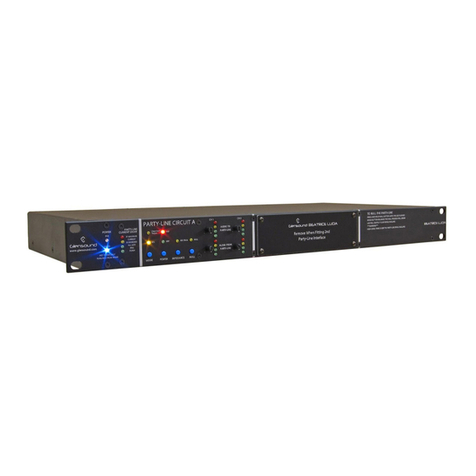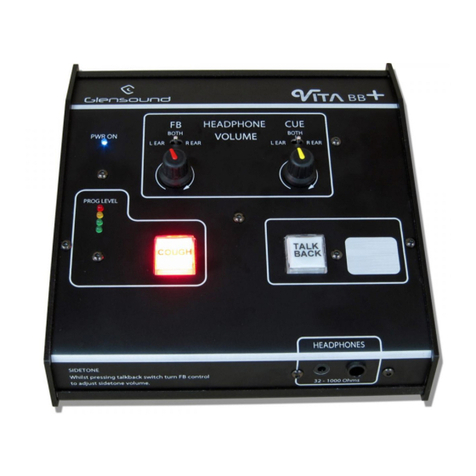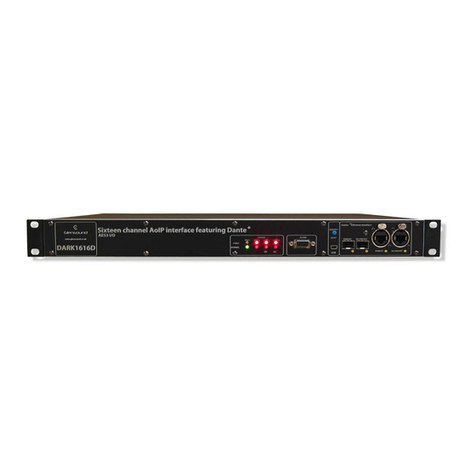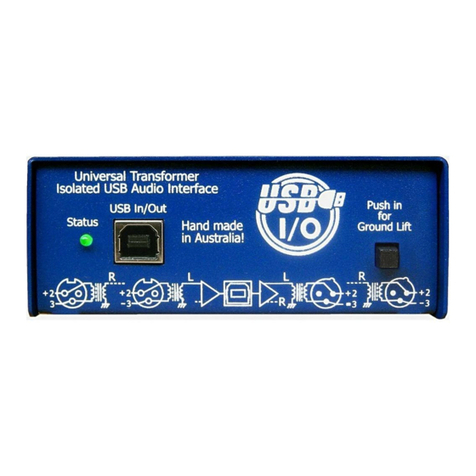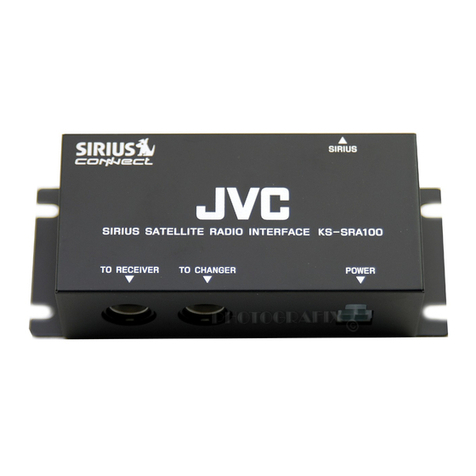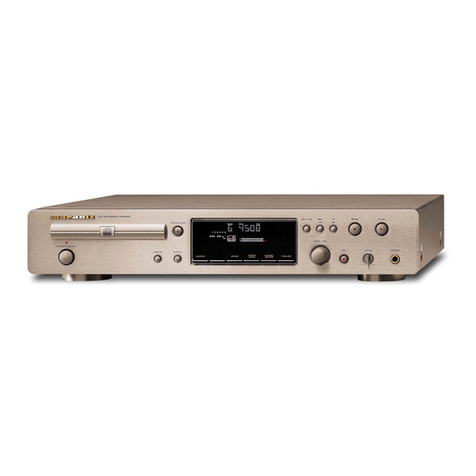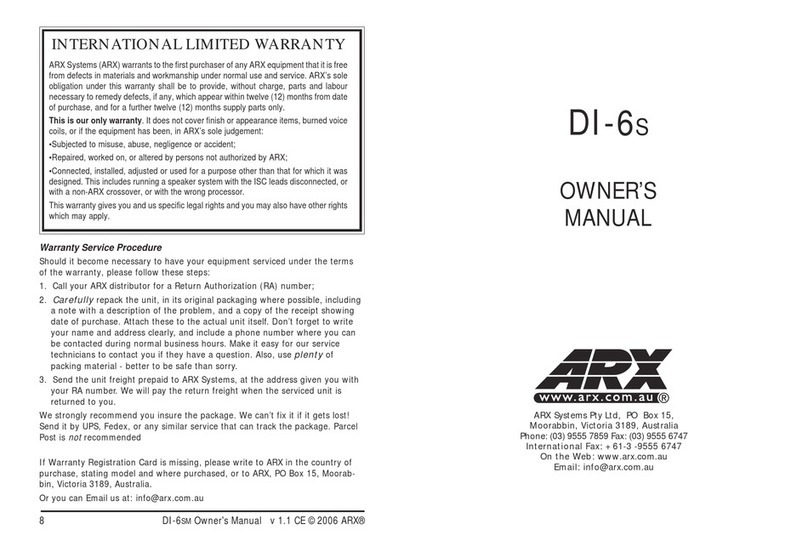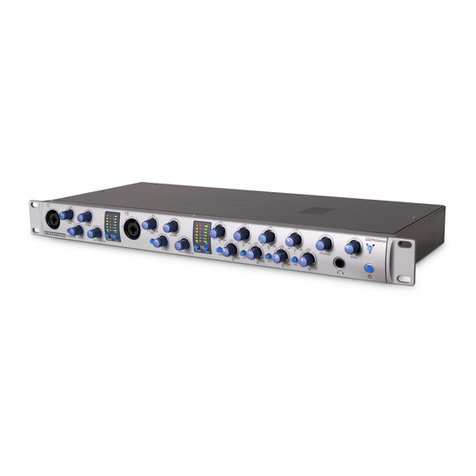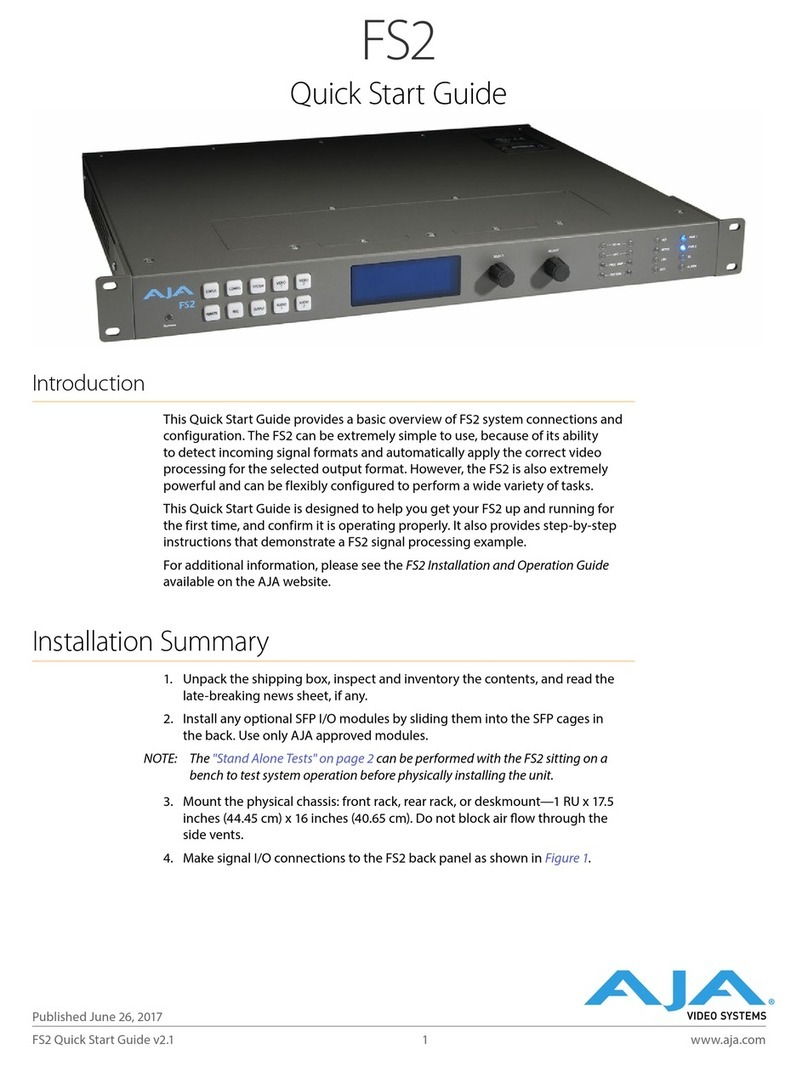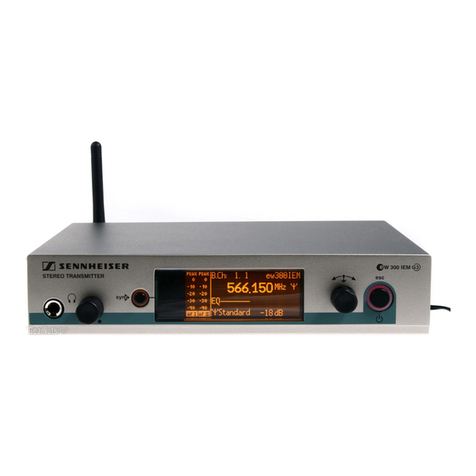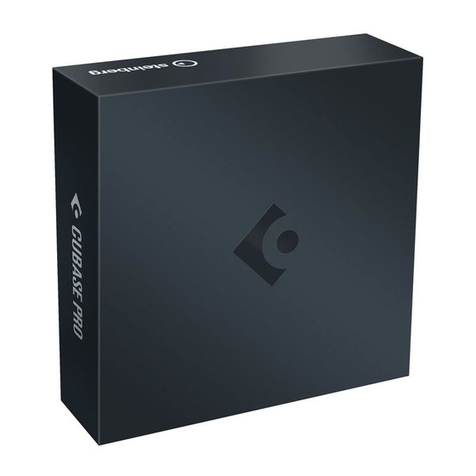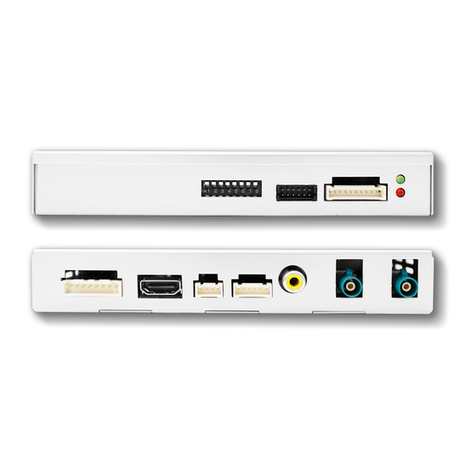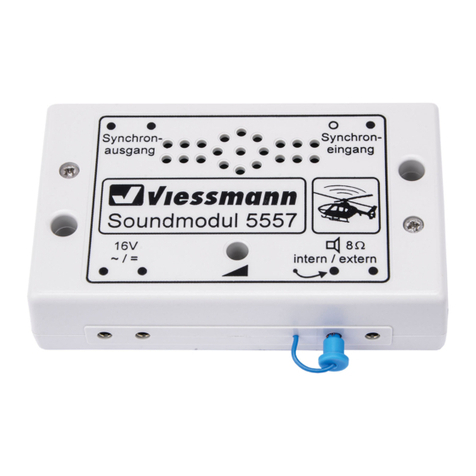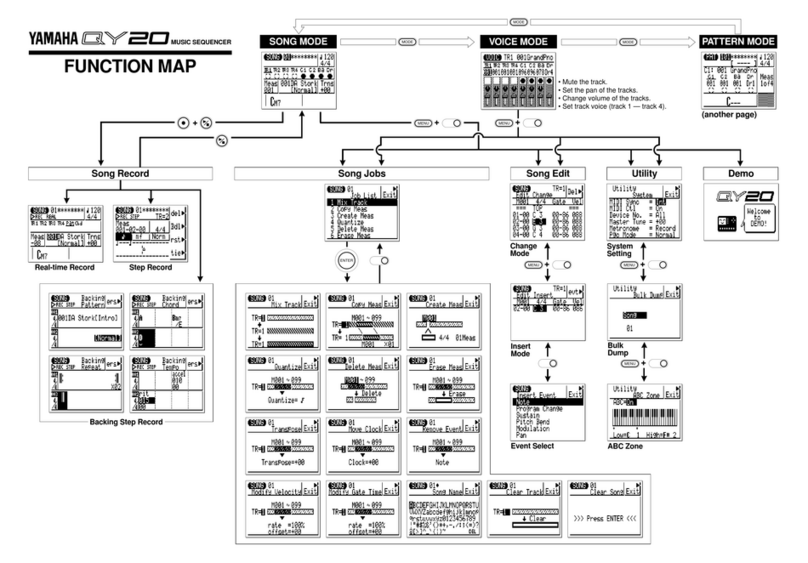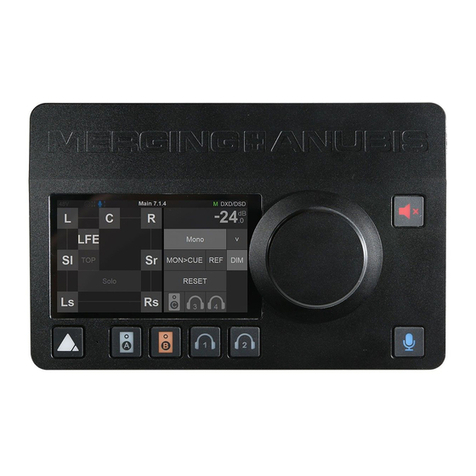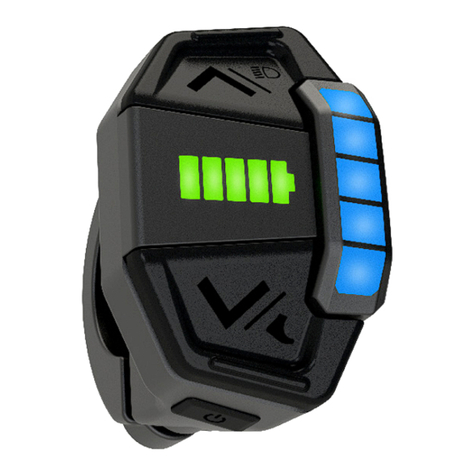Glensound SD1+ User manual

SD1+
Audio Silence Detector
User Guide
Glensound
6 Brooks Place, Maidstone
Kent, UK, ME14 1HE
Tel: +44 (0)1622 53662
www.glensound.co.uk

Page 2 of 22
Glensound Electronics Ltd
Thank you for choosing a new Glensound product.
All rights reserved.
Information contained in this manual is subject to change without notice, if in
doubt please contact us for the latest product information.
If you need any help with the product then we can be contacted at:
Glensound lectronics Ltd
1 – 6 Brooks Place
Maidstone
Kent
M 14 1H
United Kingdom
Telephone: +44 (0) 1622 753662
Fax: +44 (0) 1622 762330
MAIL ADDR SS S
General enquires: office@glensound.co.uk
Technical enquires: techinfo@glensound.co.uk
Sales enquires: sales@glensound.co.uk

Page 3 of 22
IMPORTANT SAFETY INSTRUCTIONS
1) Read these instructions
2) Keep these instructions
3) Heed all warnings
4) Follow all instructions
5) Do not use this apparatus near water
6) Clean only with a dry cloth
7) Do not block any ventilation openings. Install in accordance with manufacturer s
instructions
8) Do not install near any heat sources such as radiators, heat registers, stoves, or other
apparatus (including amplifiers) that produce heat
9) Do not defeat the safety purpose of the polarized or grounding type plug. A polarized plug
has 2 blades with one wider than the other. A grounding type plug has 2 blades and third
grounding prong. The wider blade or the 3
rd
prong are provided for your safety. If the
provided plug does not fit into your outlet, consult an electrician for replacement of the
obsolete outlet
10) Protect the power cord from being walked on or pinched, particularly at plugs,
convenience receptacles and the point where they exit from the apparatus
11) Only use attachments/ accessories specified/ supplied by the manufacturer
12) Use only with the cart, stand, tripod, bracket, or table specified by the
manufacturer, or sold with the apparatus. When a cart is used, use caution when moving
the cart/ apparatus combination to avoid injury from tip over
13) Unplug tis apparatus during lightning storms or when unused for long periods of time
14) Refer all servicing to qualified service personnel. Servicing is required when the apparatus
has been damaged in any way, such as power supply cord or plug is damaged, liquid has
been spilled or objects have fallen into the apparatus, the apparatus has been exposed to
rain or moisture, does not operate normally, or has been dropped
15) Do not attempt to modify this product. Doing so could result in personal injury and/ or
product failure
This symbol is intended to warn that
dangerous voltages within the product are
present and constitute a risk of electric
shock.
This symbol is intended to highlight that
there are important operating &
maintenance instructions in the literature
accompanying this unit.

Page 4 of 22
IMPORTANT: MAINS PLUG WIRING INSTRUCTIONS
This Signature unit is supplied with a moulded mains plug fitted to the AC mains
lead.
Mains wiring colours/ connections:
The reen/ Yellow or reen wire must be connected to the terminal in the plug
marked ‘E’ or with the Earth Symbol.
The Blue or Black wire must be connected to the terminal in the plug marked ‘N’
(Neutral).
The Red or Brown wire must be connected to the terminal in the plug marked ‘L’
(Live).
THIS UNIT MUST BE EARTHED
THIS UNIT IS FITTED WITH AN INTERNAL MAINS FUSE.
The fuse is located internally between the Live terminal of the IEC plug and the
Live input of the power supply. The fuse should only be changed by a qualified
service engineer. If replacing the fuse care should be taken to fit a correctly rated
replacement. The fuse rating can be found in the technical specifications page of
this handbook.

Page 5 of 22
CE
This equipment manufactured by Glensound lectronics Ltd of Brooks Place
Maidstone Kent M 14 1H is
CE
marked and conforms to:
Low Voltage Directive: N60065
missions: N55103.1
Immunity: N55103.2
WASTE ELECTRICAL AND ELECTRONIC EQUIPMENT
REGULATIONS 2006 (WEEE)
Glensound lectronics Ltd is registered for business to business sales of W in
the UK our registration number is:
W /JJ0074UR
RoHS2 DIRECTIVE
C directive 2011/65/ U restricts the use of the hazardous substances listed below
in electrical and electronic equipment.
This product conforms to the above directive and for this purposes, the maximum
concentration values of the restricted substances by weight in homogenous
materials are:
Lead
0.1%
Mercury
0.1%
Hexavalent Chromium
0.1%
Polybrominated Biphenyls
0.1%
Polybrominated Diphenyl thers
0.1%
Cadmium
0.01%

Page 6 of 22
PRODUCT WARRANTY:
All equipment is fully tested before dispatch and carefully designed to provide you
with trouble free use for many years.
We have a policy of supporting products for as long as possible and guarantee to
be able to support your product for a minimum of 10 years.
For a period of one year after the goods have been despatched the Company will
guarantee the goods against any defect developing after proper use providing
such defects arise solely from faulty materials or workmanship and that the
Customer shall return the goods to the Company’s works or their local dealer.
All non-wear parts are guaranteed for 2 years after despatch and any defect
developing after proper use from faulty materials or workmanship will be repaired
under this warranty providing the Customer returns the goods to the Company's
works or their local dealer.

Page 7 of 22
SD1+ Audi Silence Detector
Handbook Contents
Issue 1,
Description Page No.
Contents
IMPORTANT SAFETY INSTRUCTIONS ........................................................................................................................ 3
PRODUCT WARRANTY: ...................................................................................................................................................... 6
Handbook Contents ............................................................................................................................................................. 7
OVERVIEW .......................................................................................................................................................................... 9
PHYSICAL INSTALLATION ............................................................................................................................................... 1
BLOCK DIAGRAM ............................................................................................................................................................. 12
EXAMPLES OF USE ........................................................................................................................................................... 13
1.
S ereo Radio S a ion Transmi er Si e ............................................................................................................... 13
USER CONTROLS FRONT ................................................................................................................................................. 15
1.
Main Ac ive LEDs ................................................................................................................................................ 15
2.
Aux Ac ive LEDs .................................................................................................................................................. 15
3.
Res ore Push Swi ches ....................................................................................................................................... 15
4.
Force Push Swi ches ........................................................................................................................................... 15
5.
Selec Push Swi ch.............................................................................................................................................. 15
6.
Backli Display ..................................................................................................................................................... 16
7.
Adjus Ro ary Encoder ....................................................................................................................................... 16
USER CONTROLS REAR .................................................................................................................................................... 16
8.
GPIO ‘D’ Connec or ............................................................................................................................................ 16
9.
Aux Inpu 10dB Gain .......................................................................................................................................... 16
SETUP MENU AND OPTIONS ........................................................................................................................................... 17
En ering Se up Menus ................................................................................................................................................. 17
1.
Threshold ............................................................................................................................................................ 17
2.
Fail Delay ............................................................................................................................................................. 17
3.
Recovery Delay ................................................................................................................................................... 17
4.
Au o Recover ...................................................................................................................................................... 17
5.
Link/spli .............................................................................................................................................................. 17
6.
Mono Firs ........................................................................................................................................................... 18
7.
Smar Fail............................................................................................................................................................. 18
8.
Smar Recovery ...................................................................................................................................... 18

Page 8 of 22
9.
S ar GPIO ............................................................................................................................................................ 18
WIRING INFORMATION ................................................................................................................................................... 19
1.
S andard Pin Ou s............................................................................................................................................... 19
2.
Wiring o unbalanced devices ........................................................................................................................... 2
3.
GPIO Wiring ......................................................................................................................................................... 21
TECHNICAL SPECIFICATION ............................................................................................................................................ 22

Page 9 of 22
OVERVIEW
The Signature SD1+ is a silence detector used to s itch audio to a backup source hen the
primary audio source falls belo accepted silence thresholds in level or time. These are often
used on a broadcast path to prevent dead air should a technical problem occur ith the
audio.
The audio connections are stereo, on analogue XLRs. There is an input pair for the primary
source, and an input pair for the backup source. The SD1+ can also be configured as a t in
single channel silence detector. The backup source is usually coming from an audio player
hich can be remotely started by the SD1+ via a GPO should silence be detected.
Each channel can have the configuration parameters set independently. The threshold at
hich the unit detects a lo level is configurable, as is the amount of time that the audio
needs to be under this level before an alarm condition is triggered and the audio is s itched
to the backup input.
A comprehensive set of GPIOs allo for triggering external devices hen the secondary input
has been triggered.
Intelligent modes can be set to allo for s itching back to the primary audio source once a
sustained audio level has returned.
With a stereo audio source, if one channel should fail, the SD1+ can be set to s itch this single
input to both outputs, making a problem unnoticeable to any listeners, hilst at the same
time still providing alarm outputs so the engineers can be alerted.
The SD1+ is po ered from an internal s itch mode mains po er supply fed from a filtered
IEC mains plug suitable for use World ide. It has an internal fuse for safety. The unit can also
alternatively be po ered from an external +/-12V DC po er source (such as the Signature
Series PS1). If both mains and external DC po er sources are present then, if one po er
source ere to fail the unit ould continue to ork seemlessly from the other source.

Page 10 of 22
PHYSICAL INSTALLATION
The Glensound Signature Series have been designed to be highly versatile for installation and
can be installed in 19” racks ith either their front or rear panels facing the front of the rack.
They can also be mounted underneath desks or ork tops and can be either permananetly
mounted or stood (using the supplied feet) on top of desks or orktops.
INSTALLING SIGNATURE SERIES IN A 19” RACK
Firmly hold the signature subrack ithin the 19” rack and locate in 1RU of space. Use the
supplied 6mm rack scre s to securly attach the unit to the rack.
INSTALLING ADHSIVE FEET FOR NON PERMANENT TABLE TOP MOUNTING
Remove the front rack ears (if they are not required), turn the unit upside do n and attach
the supplied 4 sticky feet as per the above dra ing.
Signature
g
Series
Keeps Working
PWR ON
PART No
CE
W
50/60Hz 2.7 Watts
100-240V
+/-12V - - -
PIN 1 = GND
PIN 3 = -12V (100mA)
PIN 2 = +12V (100mA)
Top

Page 11 of 22
SWAPPING RACK EARS TO ALLOW THE REAR TO BE INSTALLED AT THE FRONT OF A
RACK
First remove the 4 silver button head scre s that fix the rack ears onto the front of the unit as
sho n in the top picture above.
Remove the rack ears and turn the unit around for access to its back panel.
Re-fit the 2 rack ears using the same 4 silver button head scre s that ere removed from the
front as per the bottom picture above.
USING THE MOUNTING HOLES FOR PERMANENTLY ATTACHING THE UNIT ABOVE OR
BELOW A WORKTOP/ DESK
Use either the top or bottom mounting holes as indicated above to use suitable scre s to
attach the signature unit to a orktop or bench. **PLEASE ENSURE THAT YOU USE SUITABLE
FIXINGS**
Series
Signature
g
K eep s Wo rkin g
PWR ON
PART No
CE
W
50/60Hz 2.7 Watts
100-240V
+/-12V - - -
PIN 1 = GND
PIN 3 = -12V (100mA)
PIN 2 = +12V (100mA)
Series
Signature
g
Keeps Working
PART No
PWR ON

Page 12 of 22
BLOCK DIAGRAM
MAIN IN LEFT
MAIN IN RIGHT
FAILSAVE RELAYS
100 - 240 VAC
INTERNAL
FUSE
AC/DC PSU +12V
-12V
EXT DC +/-12V
DC:DC +3.3V
AUX IN LEFT
AUX IN RIGHT
+10d
ADC
DSP
ADC
DAC
MICRO
Front
panel
display
Front panel
shaft encoder
Main In A Good
Main In Good
Main In A Selected
Main In Selected
Remote Start Aux A
Remote Start Aux
GENERAL PURPOSE OUTPUTS (GPO)
Solid state relays (Loops closed when active)
GENERAL PURPOSE INPUTS (GPI)
(Pull to ground to activate)
Force Aux A to Output
Force Aux to Output
Force Main A to Output
Force Main to Output
5 off
Front Panel Switches

Page 13 of 22
EXAMPLES OF USE
1 Stereo Radio Station Transmitter Site
Mixer
Output
Backup
Audio Source
Switch
Notification
Forced
Switch
FM
Transmiter
2 x XLR3 2 x XLR3
2 x XLR3
GPO GPO
GPI
This is the typical application for the SD1+ Silence Detector. It acts as a master fail alarm for
main programme audio for a radio station.
The main stereo programme audio from the mixer or the automation PC connects to the
SD1+ as the primary audio source. In normal operation, this audio passes straight through to
the stereo outputs of the SD1+ hich connect to the transmitter.
An audio threshold needs to be set in order for the SD1+ to make a silence detection. This is
achieved by setting an audio level threshold, under hich the SD1+ ill start a timer. The
audio threshold is configurable from -60dB to -10dB and the timer is also configurable from 5
seconds to 5 minutes. These levels are often set at different points depending on the nature
of the source audio.
Once the primary audio source has been under the threshold for the preset amount of time,
the SD1+ ill silently s itch to the backup stereo input. A remote start ill also be triggered
to start playing the backup audio source, hich is no connected directly to the main stereo
outputs. A further GPO is also triggered to notify an external system that the SD1+ is no
operating using the backup audio source. This ill alert the engineers to investigate.
GPI control is al ays available by an external system to allo engineers to manually s itch
bet een the primary and backup inputs. If the SD1+ is set in manual mode, then an external
GPI s itch ould be needed to s itch back to the primary input.
In automatic mode, after the backup audio source has been selected, the primary audio
source is still being continually monitored to check for the return of the audio. When the
primary source has been active again for a preset amount of time, the SD1+ ill silently
s itch back to the primary source. The recovery time to automatically s itch back to the
primary input can be set bet een 5-60 seconds.

Page 14 of 22
2 Two Mono Audio Feeds
Mono
Feed 1 Mono
Feed 2
Switch
Notification 2
Forced
Switch 2
Forced
Switch 1
Backup
Audio Source Backup
Audio Source
TransmiterTransmiter
1 x XLR3 1 x XLR31 x XLR3 1 x XLR3
1 x XLR31 x XLR3
GPO GPO
GPO
GPO
GPI MONO FEED 2
GPI MONO FEED 1
Switch
Notification 1
The SD1+ is effectively t o single channel silence detectors. The example above sho s the
operation of the unit hen it is monitoring 2 separate mono signals, as a t in master fail
alarm. All functions are duplicated on both sides of the unit, and they can be set
independently. The info belo is the same for mono feed 1 and selectable separately for
mono feed 2.
The mono feed audio from a mixer or link connects to the SD1+ as the primary audio source.
In normal operation, this audio passes straight through to output of the SD1+ hich connects
to the transmitter.
An audio threshold needs to be set in order for the SD1+ to make a silence detection. This is
achieved by setting an audio level threshold, under hich the SD1+ ill start a timer. The
audio threshold is configurable from -60dB to -10dB and the timer is also configurable from 5
seconds to 5 minutes. These levels are often set at different points depending on the nature
of the source audio.
Once the primary audio source has been under the threshold for the preset amount of time,
the SD1+ ill silently s itch to the backup mono input. A remote start ill also be triggered
to start playing the backup audio source, hich is no connected directly to the primary
mono output. A further GPO is also triggered to notify an external system that the SD1+ is
no operating using the backup audio source. This ill alert the engineers to investigate.
GPI control is al ays available by an external system to allo engineers to manually s itch
bet een the primary and backup inputs. If the SD1+ is set in manual mode, then an external
GPI s itch ould be needed to s itch back to the primary input.
In automatic mode, after the backup audio source has been selected, the primary audio
source is still being continuously monitored to check for the return of the audio. When the
primary source has been active again for a preset amount of time, the SD1+ ill silently
s itch back to the primary source. The recovery time to s itch back to the primary input can
be set bet een 5-60 seconds.

Page 15 of 22
USER CONTROLS FRONT
1 Main Active LEDs
When on these 2 LEDs indicate that the main audio input is being routed to the output. If
flashing they indicate that the main audio input is being forced by the user to the output and
therefore the automatic s itching of the silence detector is being bypassed.
2 Aux Active LEDs
When on these 2 LEDs indicate that the aux audio input is being routed to the output. If
flashing they indicate that the aux audio input is being forced by the user to the output and
therefore the automatic s itching of the silence detector is being bypassed.
3 Restore Push Switches
Pressing and holding these s itches for about 3 seconds ill force the associated main input
to the output (The main active LEDs ill flash to indicate this). Once in the ‘forced’ mode
another quick press of this s itch ill return the silence detector to full automatic mode.
4 Force Push Switches
Pressing and holding these s itches for about 3 seconds ill force the associated aux input to
the output (The main active LEDs ill flash to indicate this). Once in the ‘forced’ mode another
quick press of this s itch ill return the silence detector to full automatic mode.
5 Select Push Switch
Pressing and holding this s itch for about 3 seconds ill allo access to the setup up menu
hich once entered ill appear on the display. Once in the setup menu each press of this
s itch selects the next menu option. (Note to exit the setup menu the ‘Adjust Rotary Encoder’
should be pushed)
1.
Main Active LEDs
4.
Aux Active LEDs
3.
Restore Push S itches
6.
Force Push S itches
7.
Select Push S itches
5.
Backlit Display
2.
Adjust Rotary Encoder

Page 16 of 22
6 Backlit Display
This 2 line display provides a clear indication of the state of the current audio of the silence
detectors’ main inputs.
The ‘X seconds to fail’ sho s ho many seconds the audio on the associated main input needs
to be belo the user set audio level threshold for before the unit ill s itch to the aux input.
The ‘X seconds to good’ indicates ho many seconds the audio on the associated main input
needs to be above the user set audio level threshold for before the unit ill s itch back to the
main input.
If in menu setup then the display ill sho the menus and related settings.
7 Adjust Rotary Encoder
The rotary encoder is only used hen in the setup menu. It has 3 functions:
1) Turning it clock ise ill depending on the menu selected increase time, increase level
or select another option (if available).
2) Turning it anticlock ise ill depending on the menu selected decrease time, decrease
level or select another options (if available).
3) Pushing it in about 1 mm until a click is felt (it is a s itch) ill save any alterations and
exit the setup menu. Note that pushing it in if you are not in the setup menu ill have
no effect.
USER CONTROLS REAR
8 GPIO ‘D’ Connector
This General Purpose Input & Output (GPIO) provides 6 solid state relay outputs and 4 inputs
to allo basic remote control and remote indication of the silence detector’s status.
9 Aux Input 10dB Gain
This toggle s itch adds 10dB of gain to the Aux input, useful if your back up source is a
domestic audio source such as a CD player ith unbalanced outputs here the nominal
output level from the unbalanced source is likely to be -10dB.
8.
GPIO ‘D’ Connector
9.
Aux Input 10dB Gain

Page 17 of 22
SETUP MENU AND OPTIONS
Entering Setup Menus
Press & hold the yello ‘SELECT’ push s itch (next to the display) for about 4 seconds until the
display changes and sho s the first menu option.
Once in setup mode pressing the ‘SELECT’ s itch again ill move through the menus.
1 Threshold
The ‘Threshold’ is the audio level in dB that the input must fall belo before the silence
detector starts the countdo n timer prior to s itching the audio source.
The threshold can be set bet een -60 & -10dB
2 Fail Delay
The ‘Fail Delay’ is the length of time in seconds or minutes and seconds that the main audio
input must be belo its threshold setting before the silence detector ill s itch the aux input
to the output.
The fail delay can be set bet een 5s (5 seconds) and 5m00s (5 minutes & 0 seconds).
3 Recovery Delay
The ‘Recovery Delay’ is the length of time in seconds or minutes and seconds that the main
audio input must be above its threshold setting before the silence detector ill s itch the
main input back to the output.
The recovery delay can be set bet een 5s (5 seconds) and 60s (60 seconds).
4 Auto Recover
The ‘Auto Recover’ mode determines hen the silence detector s itches back to the main
inputs after silence had been detected and the Aux inputs are being routed to the outputs.
Option 1 is ‘Auto’ here the silence detector ill automatically s itch back to the main inputs
as soon as valid audio appears on them (as per the settings in menu 1 & 3)
Option 2 is ‘Manual’ here the Aux inputs continue to be routed to the outputs even after
valid audio returns to the main inputs. The front ‘Restore’ yello push s itches must be
pushed or the rear ‘force loops’ must be made manually in order to return the main inputs to
the outputs.
5 Link/split
The ‘Lin /split’ menu provides the option of associating the 2 inputs (A & B) together (i.e.
Lin ing or treating the inputs as stereo) or treating the A & B inputs as completely separate
audio circuits ith no correlation ith each other (i.e. Splitting or treating the inputs as
individual Mono circuits (Dual Mono)).

Page 18 of 22
6 Mono First
The ‘Mono First’ menu is only active if the link/split menu is set to ‘Stereo’. There are 2 options
ithin this menu, Yes & No.
If set to ‘Yes’ then if one input of the stereo pair fails then the remaining good input ill be
s itched to both outputs. (If both inputs of the stereo pair fail then the aux input ill be
routed to the output).
If set to ‘No’ then if just one input of the stereo pair fails then the silence detector ill route
the aux inputs to both outputs.
7 Smart Fail
The ‘Smart Fail’ option is designed to add some intelligence to the silence detection and to try
to prevent false triggers.
Smart Fail Mode I adds a requirement for a 4s minimum length of audio before the fail
countdown is reset, and is intended to prevent clicks, etc. on an otherwise dead line from
being recognised as valid audio.
There are 2 options in the smart fail mode: On or Off
8 Smart Recovery
The ‘Smart Recovery’ option is designed to add some intelligence to the silence detector and
prevent false recovery happening due to noise on the main circuits.
Smart Recover Mode I allo s brief periods of subthreshold audio embedded in an other ise-
valid signal ithout resetting the recovery countdo n. This actually loosens the criteria for
valid audio, but should be a better match for some real- orld signals and may allo the
threshold level to be set higher for greater overall discrimination.
There are 2 options in the smart recovery mode: On or Off
9 Start GPIO
The ‘Start GPIO’ menu alters the units ‘Remote Start Aux A’ and ‘Remote Start Aux B’ loop
outputs. These outputs are usually connected to external equipment and used to tell that
external equipment to start sending audio.
The ‘Remote Start Aux A’ and ‘Remote Start Aux B’ loop outputs become active hen the
main audio inputs have failed and the silence detector s itches to the Aux inputs.
There are 2 options for the ‘Start GPIO’ menu: ‘Continuous’ or ‘Pulsed’.
When active & set to ‘Continuous’ the loop output ill be permanently on.
When active & set to ‘Pulsed’ the loop output ill alternate bet een on and off.

Page 19 of 22
WIRING INFORMATION
1 Standard Pin Outs
HEADPHONE WIRING NOTE:
The Signature Series range of products feature sophisticated headphone amplifiers whose stereo
outputs can be connected directly to mono headphone jacks without damaging the headphones
internal amplifiers.
12
3
XLR SOCKET (FEMALE)
1 2
3
XLR PLUG (MALE)
TIP
RING
SLEEVE
STANDARD XLR AUDIO PINOUTS:
1: Ground/ Earth
2: INPHASE/ POSITIVE/ MIC
3: MATE/ NEGATIVE/ MIC -
STANDARD HEADPHONE WIRING
:
TIP: A/ LEFT Ear
RING: B/ RIGHT Ear
SLEEVE: Common/ Earth

Page 20 of 22
2 Wiring to unbalanced devices
The input & output circuits of the Signature Series can be connected to unbalanced (domestic
style) devices. The iring diagrams belo sho a mono jack plug as the unbalanced end of
the cable but this of course could easily be a different type of connector such as an RCA
Phono or ‘D’ type connector.
TO TIP
TO SLEEVE
TO TIP
TO SLEEVE
BALANCED OUTPUT
ON SIGNATURE UNIT
UNBALANCED INPUT
OF EXTERNAL DEVICE
BALANCED INPUT
ON SIGNATURE UNIT UNBALANCED OUTPUT
OF EXTERNAL DEVICE
12
3
21
3TIP
SLEEVE
TIP
SLEEVE
Table of contents
Other Glensound Recording Equipment manuals

Glensound
Glensound DARK1616 Installation guide
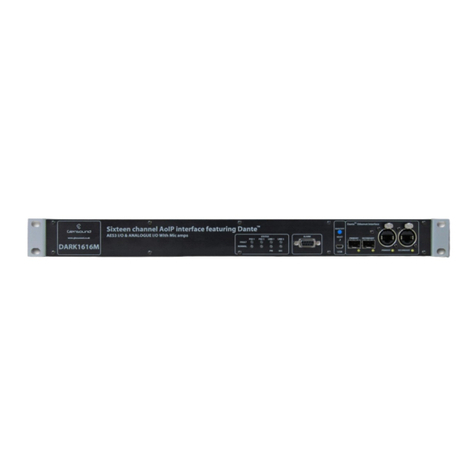
Glensound
Glensound DARK1616M Installation guide

Glensound
Glensound DARK8ADI Installation guide

Glensound
Glensound GS-GC5/USB Installation guide

Glensound
Glensound DANTE DARK8MAI Installation guide
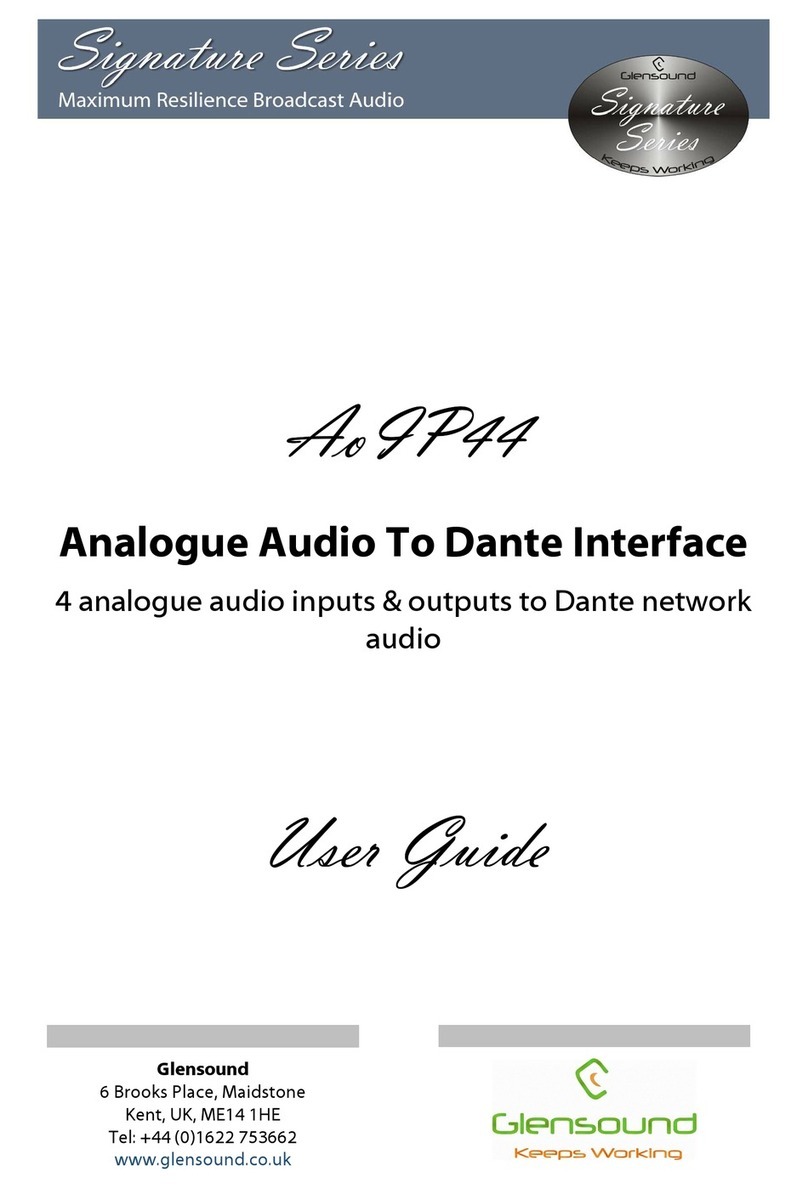
Glensound
Glensound Signature Series User manual

Glensound
Glensound DARK16I User manual

Glensound
Glensound AOIP22 Installation guide
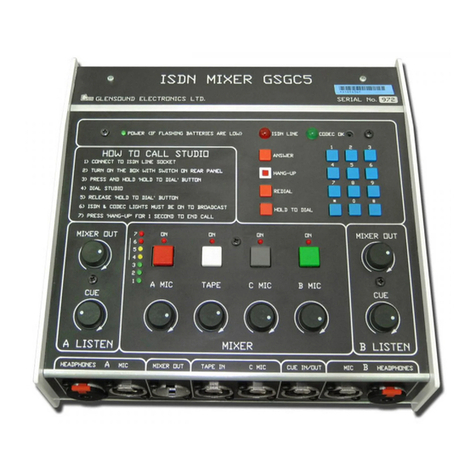
Glensound
Glensound Glensound GSGC5 User manual
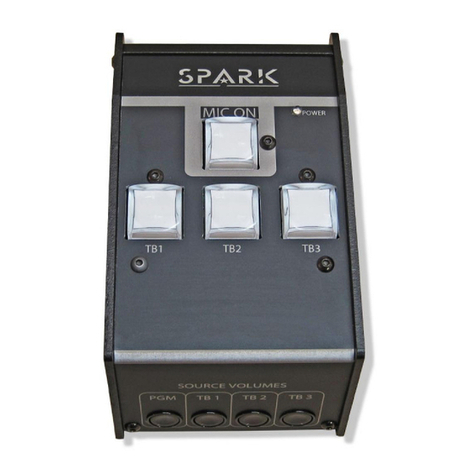
Glensound
Glensound SPARK Installation guide
